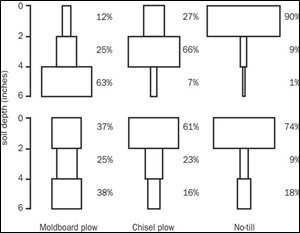I recently met with a grower who wanted to put down a preemergent herbicide to get ahead of winter weeds. The crop he is growing has very limited choices but Surflan A.S. could be used. Surflan and other members of the dinitroaniline class of herbicides act by disrupting cell division in the roots of germinating seeds and resulting in death of the very young seedling before it even reaches the soil surface.
However, to be effective the herbicide needs to be where the root radicle of the seeds are so it either has to be incorporated mechanically or moved into the soil through rainfall or irrigation. The commonly accepted term for this is “activation”.
From the Surflan A.S. label:
|
Activation and Cultivation: Surflan A.S. will remain stable on the soil surface up to 21 days following application. In the absence of timely rainfall, irrigation can be used to activate Surflan A.S. A minimum of one-half (1/2) inch of rain or its equivalent in sprinkler irrigation is necessary to activate Surflan A.S. |
Why ½” of water? Weed seeds are distributed throughout the soil profile but the abundance of seeds at varying depths depends on the soil type, seed size, and type of cultivation but ½” of water is usually enough to move the herbicide into the top 1-2 inches of the soil profile.
Vertical distribution of weed seeds in a loamy sand soil (top) and a silty loam soil (bottom).
Figure credit: adapted from Clements et al. (1996) by Fabian Menalled, MSU Extension, Montana State University (http://www.extension.org/pages/18527/manage-the-weed-seed-bankminimize-deposits-and-maximize-withdrawals#.Uo5DcMSHvTo).
We can see in the above figure that with the exception of moldboard plowing, most weed seeds are found in the top 4” of soil and in many cases, the top 2”. Moving the herbicide much deep than 2” does not really improve control because for most small seeded weeds, even if a seed germinates at a deeper depth, it usually dies before it reaches the surface (this called fatal germination).
Anyway, getting back to the grower and Surflan…
This grower does not have overhead irrigation and his crop has shallow roots so he can’t incorporate so he wanted to apply the herbicide and wait for some natural rainfall to activate the herbicide. Surflan is an herbicide where you do have that flexibility since it is stable on the soil surface for about 21 days.
But here’s the catch and the take-home message: While there is about a 21 day “grace period” weed seeds are still going to be germinating and since the young roots aren’t encountering the herbicide they will not be controlled.
From the Surflan A.S. label:
|
If weeds begin to emerge due to lack of rainfall or irrigation, shallow cultivate 1 to 2 inches deep to destroy existing weeds or remove them by hand. Shallow cultivation to a depth of 1 to 2 inches will enhance herbicidal effectiveness. If Surflan A.S. is not activated by rainfall, irrigation or cultivation within 21 days of application or existing weeds have not been removed, erratic weed control may result. |
Luckily, the grower got it down just before a light but steady two days of rain so I expect that he will be ok.
So if you are going to be applying a herbicide that requires activation and you want to take advantage of the winter rains to do it, make sure you time the application within a few days of expected rainfall or else you may not get the control you expect.
